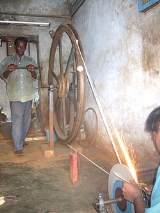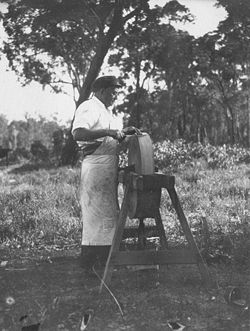
Sharpening
Encyclopedia
Sharpening is the process of creating or refining a sharp edge of appropriate shape on a tool or implement designed for cutting. Sharpening is done by grinding away material on the implement with an abrasive
substance harder than the material of the implement, followed sometimes by processes to polish the sharp surface to increase smoothness and to correct small mechanical deformations without regrinding.
or drawknife
), blades can be sharpened to 30 degrees.
 Many implements have a cutting edge which is essentially straight. Knives
Many implements have a cutting edge which is essentially straight. Knives
, chisel
s, straight-edge razor
s, and scissors
are examples. Sharpening a straight edge is relatively simple, and can be done by using either a simple sharpening device which is very easy to use but will not produce the best possible results, or by the skillful use of oil or water grinding stones
, grinding wheels, hones, etc.
Sharpening these implements can be expressed as the creation of two intersecting planes which produce an edge that is sharp enough to cut through the target material. For example, the blade of a steel knife
is ground to a bevel so that the two sides of the blade meet. This edge is then refined by honing until the blade is capable of cutting.
The extent to which this honing takes place depends upon the intended use of the tool or implement. For some applications an edge with a certain amount of jaggedness is acceptable, or even desirable, as this creates a serrated cutting edge
. In other applications the edge must be as smooth as possible.
, or a succession of increasingly fine stones, which shape the blade by removing material; the finer the abrasive the finer the finish. Then the edge may be stropped
by polishing the edge with a fine abrasive such as rouge
or tripoli
on a piece of stout leather or canvas. The edge may be steeled or honed by passing the blade against a hard metal "steel" (which may be made of ceramic) which plastically
deforms and straightens the material of the blade's edge which may have been rolled over irregularly in use, but not enough to need complete resharpening.
Examples include:

Abrasive
An abrasive is a material, often a mineral, that is used to shape or finish a workpiece through rubbing which leads to part of the workpiece being worn away...
substance harder than the material of the implement, followed sometimes by processes to polish the sharp surface to increase smoothness and to correct small mechanical deformations without regrinding.
Tools and materials for sharpening
The substance on the sharpening surface must be harder (hardness is measured on the Mohs scale) than the material being sharpened; diamond is extremely hard, making diamond dust very effective for sharpening, though expensive; less costly, but less hard, abrasives are available, such as synthetic and natural Japanese waterstones.Angles
Very sharp knives sharpen at about 10 degrees (which implies that the knife's edge is a 20-degree angle). Typical knives are sharpened at 15 degrees. Knives that require a tough edge (such as those that chop) sharpen at 20 degrees or more. For an extremely durable edge (such as a chiselChisel
A chisel is a tool with a characteristically shaped cutting edge of blade on its end, for carving or cutting a hard material such as wood, stone, or metal. The handle and blade of some types of chisel are made of metal or wood with a sharp edge in it.In use, the chisel is forced into the material...
or drawknife
Drawknife
A drawknife is a traditional woodworking hand tool used to shape wood by removing shavings. It consists of a blade with a handle at each end. The blade is much longer than it is deep...
), blades can be sharpened to 30 degrees.
Implements with essentially straight edges

Knife
A knife is a cutting tool with an exposed cutting edge or blade, hand-held or otherwise, with or without a handle. Knives were used at least two-and-a-half million years ago, as evidenced by the Oldowan tools...
, chisel
Chisel
A chisel is a tool with a characteristically shaped cutting edge of blade on its end, for carving or cutting a hard material such as wood, stone, or metal. The handle and blade of some types of chisel are made of metal or wood with a sharp edge in it.In use, the chisel is forced into the material...
s, straight-edge razor
Razor
A razor is a bladed tool primarily used in the removal of unwanted body hair through the act of shaving. Kinds of razors include straight razors, disposable razors and electric razors....
s, and scissors
Scissors
Scissors are hand-operated cutting instruments. They consist of a pair of metal blades pivoted so that the sharpened edges slide against each other when the handles opposite to the pivot are closed. Scissors are used for cutting various thin materials, such as paper, cardboard, metal foil, thin...
are examples. Sharpening a straight edge is relatively simple, and can be done by using either a simple sharpening device which is very easy to use but will not produce the best possible results, or by the skillful use of oil or water grinding stones
Sharpening stone
Sharpening stones, water stones or whetstones are used to grind and hone the edges of steel tools and implements. Examples of items that may be sharpened with a sharpening stone include scissors, scythes, knives, razors and tools such as chisels, hand scrapers and plane blades...
, grinding wheels, hones, etc.
Sharpening these implements can be expressed as the creation of two intersecting planes which produce an edge that is sharp enough to cut through the target material. For example, the blade of a steel knife
Knife
A knife is a cutting tool with an exposed cutting edge or blade, hand-held or otherwise, with or without a handle. Knives were used at least two-and-a-half million years ago, as evidenced by the Oldowan tools...
is ground to a bevel so that the two sides of the blade meet. This edge is then refined by honing until the blade is capable of cutting.
The extent to which this honing takes place depends upon the intended use of the tool or implement. For some applications an edge with a certain amount of jaggedness is acceptable, or even desirable, as this creates a serrated cutting edge
Serrated blade
A serrated blade is a type of blade used on saws and on some knives or scissors. It is also known as a dentated, sawtooth, or toothed blade.A serrated blade has a cutting edge that has many small points of contact with the material being cut...
. In other applications the edge must be as smooth as possible.
Steeling
Sharpening straight edges (knives, chisels, etc.) by hand can be divided into phases. First the edge is sharpened with an abrasive sharpening stoneSharpening stone
Sharpening stones, water stones or whetstones are used to grind and hone the edges of steel tools and implements. Examples of items that may be sharpened with a sharpening stone include scissors, scythes, knives, razors and tools such as chisels, hand scrapers and plane blades...
, or a succession of increasingly fine stones, which shape the blade by removing material; the finer the abrasive the finer the finish. Then the edge may be stropped
Razor strop
A razor strop is a flexible strip of leather or canvas used to straighten and polish the blade of a straight razor, a knife, or a woodworking tool like a chisel...
by polishing the edge with a fine abrasive such as rouge
Iron(III) oxide
Iron oxide or ferric oxide is the inorganic compound with the formula Fe2O3. It is one of the three main oxides of iron, the other two being iron oxide , which is rare, and iron oxide , which also occurs naturally as the mineral magnetite. As the mineral known as hematite, Fe2O3 is the main...
or tripoli
Rotten stone
Rotten stone, sometimes spelled as rottenstone, also known as tripoli, is fine powdered rock used as a polishing abrasive in woodworking. It is usually weathered limestone mixed with diatomaceous, amorphous, or crystalline silica...
on a piece of stout leather or canvas. The edge may be steeled or honed by passing the blade against a hard metal "steel" (which may be made of ceramic) which plastically
Plasticity (physics)
In physics and materials science, plasticity describes the deformation of a material undergoing non-reversible changes of shape in response to applied forces. For example, a solid piece of metal being bent or pounded into a new shape displays plasticity as permanent changes occur within the...
deforms and straightens the material of the blade's edge which may have been rolled over irregularly in use, but not enough to need complete resharpening.
Other types of implements
Different techniques are required where the edges are not straight. Special tools and skills are more often required, and sharpening is often best done by a specialist rather than the user of the tool.Examples include:
- Drill bitDrill bitDrill bits are cutting tools used to create cylindrical holes. Bits are held in a tool called a drill, which rotates them and provides torque and axial force to create the hole. Specialized bits are also available for non-cylindrical-shaped holes....
s - SawSawA saw is a tool that uses a hard blade or wire with an abrasive edge to cut through softer materials. The cutting edge of a saw is either a serrated blade or an abrasive...
s
See also

- Grinding machineGrinding machineA grinding machine, often shortened to grinder, is a machine tool used for grinding, which is a type of machining using an abrasive wheel as the cutting tool...
- Knife sharpeningKnife sharpeningKnife sharpening may be done by grinding against a hard rough surface, typically stone, or a soft surface with hard particles, such as sandpaper.Additionally, leather razor strop, or strop, is often used to straighten and polish an edge...
- Razor stropRazor stropA razor strop is a flexible strip of leather or canvas used to straighten and polish the blade of a straight razor, a knife, or a woodworking tool like a chisel...
- Saw setSaw setA saw set is a device used in the sharpening of hand saws. Once the teeth have been jointed and filed, the saw set is used to adjust the set of each tooth....
- Scary sharpScary sharpScary sharp is a method of sharpening woodworking tools with sandpaper instead of conventional methods of oilstone or waterstone sharpening. The sandpaper referred-to here can be any abrasive impregnated sheet used in the various industries to smooth surfaces and examples include glass paper,...
- Sharpening jigSharpening jigA sharpening jig is often used when sharpening woodworking tools. Many of the tools used in woodworking have steel blades which are sharpened to a fine edge. A cutting edge is created on the blade at the point at which two surfaces of the blade meet. To create this cutting edge a bevel is formed on...
- Sharpening stoneSharpening stoneSharpening stones, water stones or whetstones are used to grind and hone the edges of steel tools and implements. Examples of items that may be sharpened with a sharpening stone include scissors, scythes, knives, razors and tools such as chisels, hand scrapers and plane blades...

